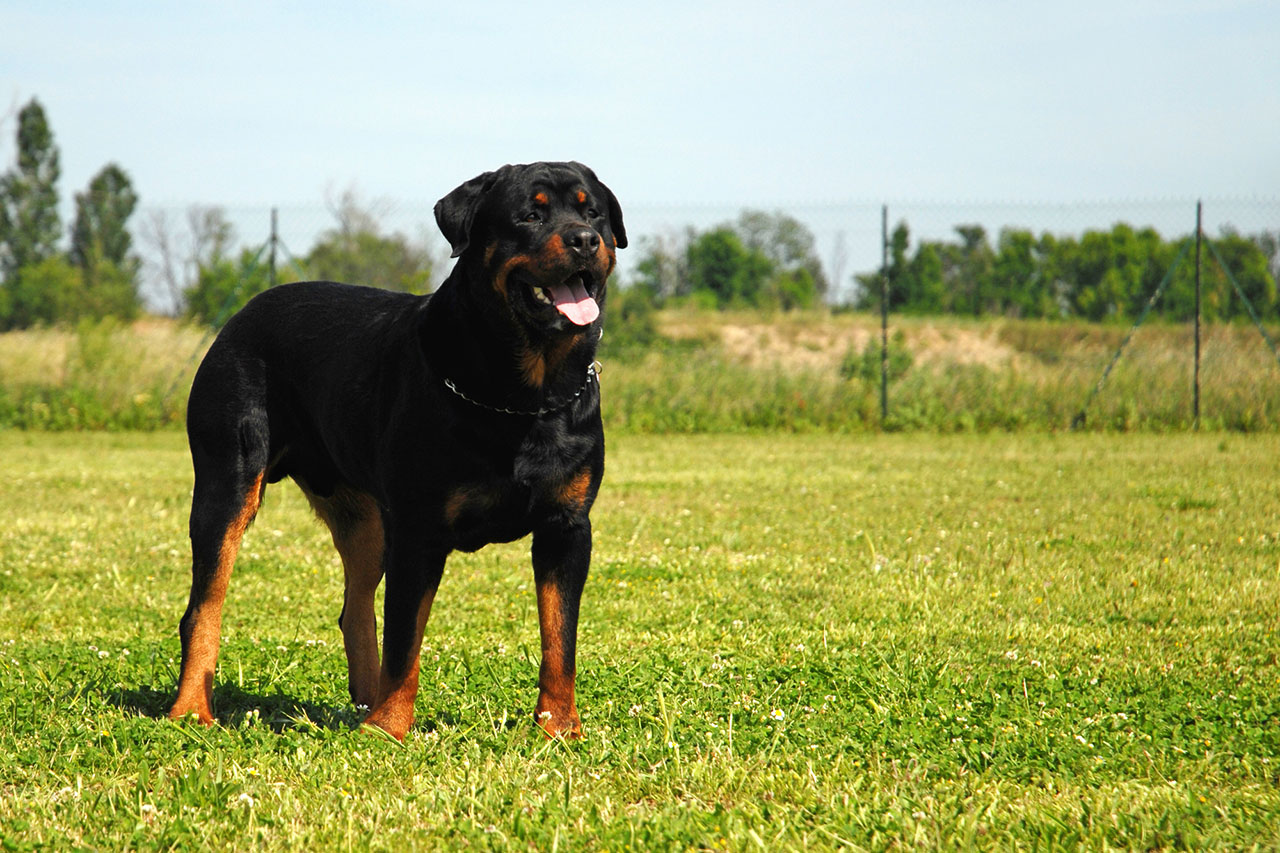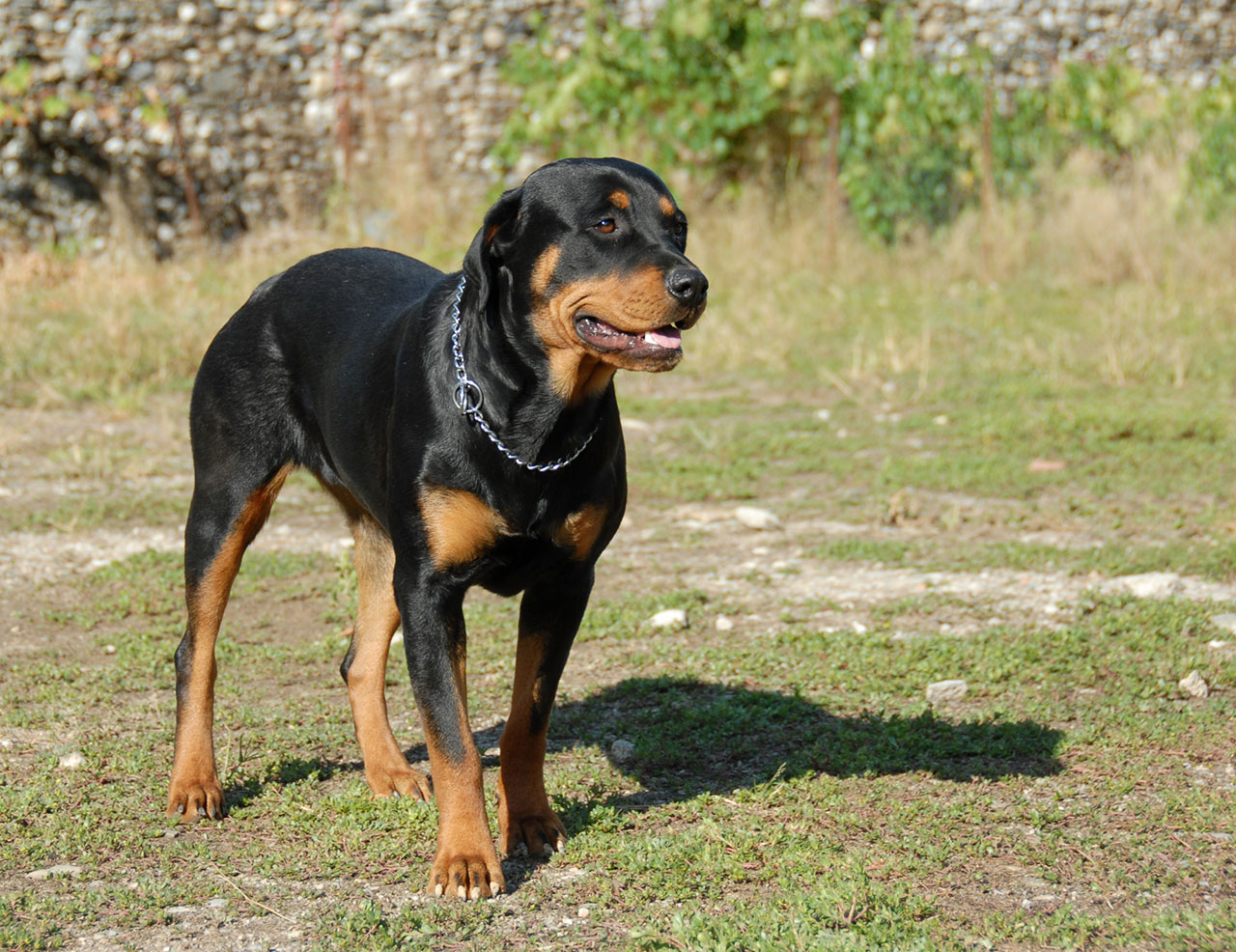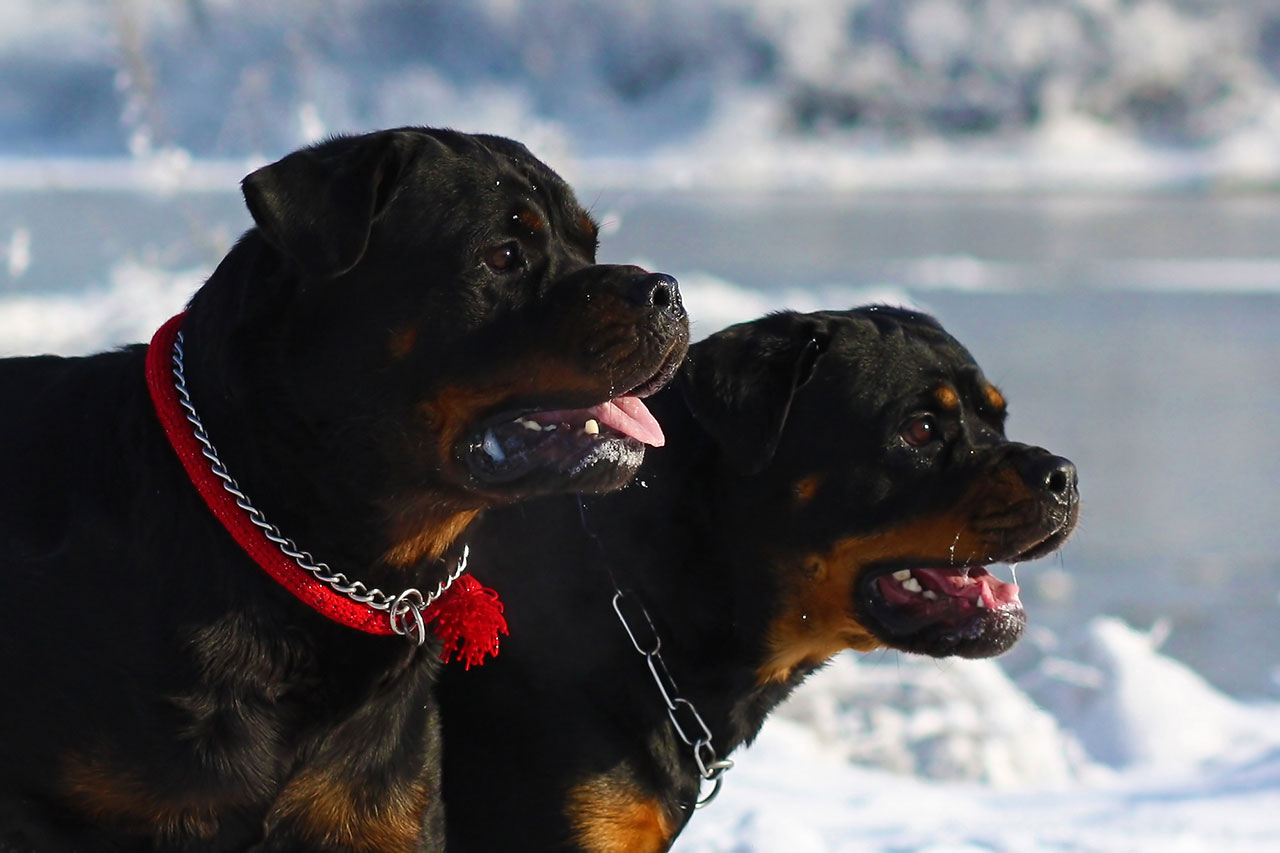Male vs Female Rottweilers: What Are the Differences?
Rottweilers are a German breed originating from southern Germany and they were bred to be a working dog with a high level of intelligence. Similar to a German shepherd, they were used for herding cattle and sheep, and they were also popular for police dogs and guard dogs. Today, Rottweilers are still used as working dogs in many parts of the world, but they’ve also become popular family pets!
Rottweilers are large breed dogs and they can weigh anywhere from 75 to 115 pounds. They have short, dense fur that is usually black with brown or tan markings. An important thing to note is that they have a double coat and their fur does shed, so they’re not the right dog for someone looking for a hypoallergenic pup. Their natural instinct is to protect their family members and they have much higher energy levels than smaller dog breeds. Responsible dog owners should expect to give adult Rottweilers a daily long walk and plenty of exercise to keep health issues at bay.
At first glance, a rottie may be a good fit for your family! They can be good pets and a very loyal companion, but they’re also strong and powerful dogs that need to be trained and socialized properly at an early age. Be sure to find a reputable breeder associated with the American Kennel Club, and make sure you’re prepared to handle a large and potentially aggressive dog.
Choosing between Male or Female Rottweiler
When deciding whether to choose a male or female Rottweiler, there are a number of factors to consider as there are significant gender differences. Male Rottweilers are typically larger, more high energy, and more muscular than females. Males with proper social skills are usually less aggressive than females, though they can still be territorial by nature. However, adult females are often more loyal and protective of their families. Female dogs in general are typically more loving and nurturing due to maternal instincts.
If you’re looking for a strong protective companion, a male Rottweiler may be the best choice. If you’re looking for a loving and nurturing pet, a female Rottweiler may be the better option. Ultimately, the best decision is the one that best suits your individual needs and personal preference!
Male Rottweiler
PROS
There are many benefits to getting a male Rottweiler. They are better protectors and make excellent guard dogs due to their large size and quick wit. Here are just a few more reasons why you might want to consider getting a male Rottweiler of your own:
1. Male Rottweilers tend to be more laid back than females. If you’re looking for a calm, easygoing dog, a male Rottweiler may be a good choice.
2. A Rottweiler male is often less aggressive than it’s female counterpart. While all Rottweilers need proper socialization and training, males are typically less likely to show aggression than females.
3. Male Rottweilers tend to be more easygoing around other dogs. If you have another dog in your home, a male Rottweiler may be a good choice – they’re typically more tolerant of other dogs than female rotties are.
4. Male Rottweilers can make excellent personal protection dogs. If you’re looking for a dog to help protect your home, a male Rottweiler may be a good option – their natural guarding instincts tend to be stronger than those of females.
5. Male Rottweilers can be great companions and tend to become strongly attached to one particular individual. If you’re looking for a loyal, loving dog to be your best friend, a male Rottweiler may be the perfect choice.
CONS
Rottweilers are one of the most popular dog breeds, but they’re not right for everyone. Here are some things to consider before getting a male Rottweiler.
1. Male Rottweilers are large dogs and require a lot of space. If you live in an apartment or other small dwelling, owning a Rottweiler dog would likely not be a good idea. These powerful dogs need room to roam and they’re not happy being cooped up all day.
2. Male Rottweilers need a lot of exercise. While they’re not the most high-energy breed out there, they still need plenty of activity to stay happy and healthy. Proper care consists of regular walks or runs one to two times a day. If you’re unsure you can commit to that, a Rottweiler may not be the right breed for you.
3. Male Rottweilers can be large and powerful dogs mixed with territorial and potentially aggressive behavior, especially if they’re not properly socialized beginning from an early age. If you’re not experienced with handling large dogs, a Rottweiler may not be the right breed for you.
4. Male Rottweilers typically require longer and more extensive training than females. They are slower to mature and have a stronger tendency to be protective and territorial. Rottweilers need firm, consistent training and plenty of exercise to release energy. Without these things, they may become destructive or even aggressive.
5. These dogs are one of the most popular dog breeds, but they are also one of the most expensive to maintain. A Rottweiler needs a high-quality diet for proper nutrition and regular vet care in order to stay healthy and happy. If you’re thinking about getting a Rottweiler, be prepared to budget for their care.
If you’re prepared to handle all of these things, then a male Rottweiler can make a great companion for you!
Female Rottweiler
PROS
There are many reasons why you might want to consider getting a female Rottweiler. Here are some of the most compelling ones:
1. Female rotties tend to be more affectionate and attached to their entire family, rather than just one individual. A female pup that receives proper training and socialization at an early age can grow up to be a gentle giant who loves spending time with her family. They can be patient and loving with young children, and make excellent playmates.
2. One of the main reasons why female Rottweilers make great indoor pets is because they are less likely to mark their territory than males. This means that you won’t have to worry about them leaving little “messes” around your home.
3. Female Rottweilers are typically smaller than their male counterparts, which means they usually require less food and exercise. Because of this, they can be a great option for those who are looking for a slightly smaller, more low-maintenance large breed dog. Keep in mind though, every individual dog is unique and their full grown size and physical differences can vary.
4. Female Rottweilers often form strong bonds with their owners and are very loyal companions. They can be very protective of their family and home, sometimes making them wary around new and different people. However, this can be beneficial as they will guard and protect their family against strangers and intruders.
CONS
While Rottweilers are generally considered to be great family pets, there are some disadvantages to getting a female Rottweiler. Listed below are the biggest disadvantages of owning a Rottweiler.
1. Female Rottweilers can be very protective of their families, which can potentially lead to aggression. While this may be a positive trait in some situations, it can also be problematic if not managed properly. Proper socialization and training is essential for keeping a female Rottweiler calm and collected in all situations.
2. Female Rottweilers when not socialized tend to be more dominant than their male counterparts, and as a result, may not do well in homes with other dogs or small children outside her immediate family. If you’re considering adding a Rottweiler to your home, it’s important to make sure that you’re prepared to handle a potentially temperamental dog.
3. Female Rottweiler puppies are often more expensive than male puppies. One of the main reasons that females tend to be more expensive than their male counterparts is because they are desirable for breeding and dog shows, which makes them more valuable to dog breeders. While there are exceptions to every rule, female Rottweilers typically command a higher price tag than male Rottweilers.
4. Rottweiler females that have not been spayed are more prone to developing health problems like hip dysplasia and elbow dysplasia. While not all Rottweilers will develop these conditions, those that do can face a range of serious complications. In addition to joint pain and mobility issues, dogs with hip or elbow dysplasia may also suffer from arthritis, which can further decrease their quality of life.
5. Finally, Female Rottweilers generally don’t live as long as male Rottweilers. The average lifespan of a Rottweiler is around 10 years, but females generally don’t live as long as males. Some health problems that are more common in females which are mentioned above include hip dysplasia, elbow dysplasia, and cranial cruciate ligament rupture. While these conditions can be treated, they can often lead to a shortened lifespan. In addition, females are also more likely to develop certain cancers, such as mammary cancer and ovarian cancer. Treatment for these conditions can be expensive and may not always be successful, so it’s important to be aware of the risks before getting a female Rottweiler.
In general, female Rottweilers are very loyal and protective of their families. They are also highly intelligent and obedient dogs, but they need to be socialized early on in order to ensure that they will get along with other dogs and people, especially human children. Proper training and socialization will help to keep your female Rottweiler well-behaved and make her a great family pet!
Female Heat Cycle
The average length of a female rottweiler’s heat cycle is about 21 days. However, this can vary somewhat from dog to dog. Some may have a shorter cycle of only 18 days, while others may have a longer one of up to 24 days.
The first half of the cycle is called the proestrus phase, during which the dog’s body is preparing for ovulation. The second half is called the estrus phase, during which ovulation actually takes place. During both of these phases, the dog’s vulva will swell and she may have a bloody discharge. She will also be more attracted to male dogs at this time.
Around day 21, if she has not mated, her cycle will end and she will return to normal. If she has mated, however, she will enter the pregnancy phase, which lasts for about 9 weeks. After that, she will enter the lactation phase, during which she will produces milk for her puppies. Finally, she will enter the post-lactation phase, during which her body will return to its normal state. At this point, her heat cycle will begin again.
Male or Female Rottweiler?
If you’re considering getting a Rottweiler, male or female, be sure to do your research and choose a reputable breeder. And remember, no matter what gender you choose, every dog is an individual and their personality traits can vary. The best thing to do is get to know your new pup before making any decisions about their place in your family.
There are many pros and cons to both male and female Rottweilers, so all in all it really depends on what you’re looking for in a dog. Male rotties tend to be more territorial and loyal, while females are typically more protective and loving. Ultimately, the best way to make a decision is to meet both sexes and see which pup you connect with the most!
Rottweiler as Great Companion
There are many reasons why Rottweiler dogs make great companions! They are loyal, protective, and loving animals that can provide many years of companionship. They are also extremely obedient and highly intelligent dogs, making them relatively easy to train. With proper training and socialization they can be ideal for families with young children or other pets. However, it is important to remember that Rottweilers are large, powerful dogs and should be treated with a firm but gentle hand. A responsible pet owner should always ensure boundaries so that their pup knows their place in the family “pack”.
Rottie’s are affectionate dogs who love to show their love for their owners. They will often stay close to their owner’s side and lean against them or rest their head on their lap to show their affection. And they are always happy to cuddle up close like a not so little lap dog! This strong bond is one of the things that makes Rottweilers such great pets.
These protective dogs will often stand guard over their family and home, and they will do anything to keep them safe. This instinct to protect is part of what makes Rottweilers such great dogs for families. But their most special quality is their unconditional love for their owners. This deep bond is what makes Rottweiler such special dogs and it’s one of the reasons why they are such popular pets!



